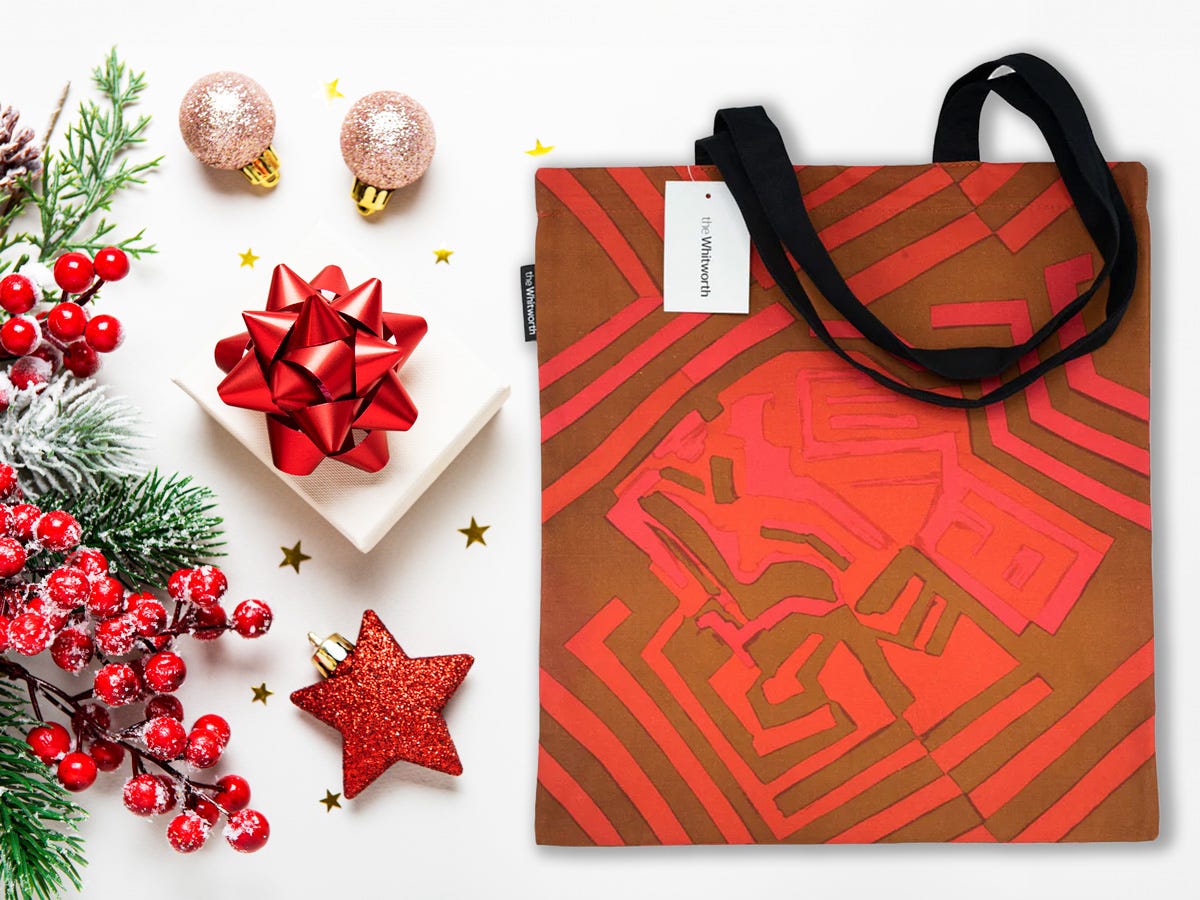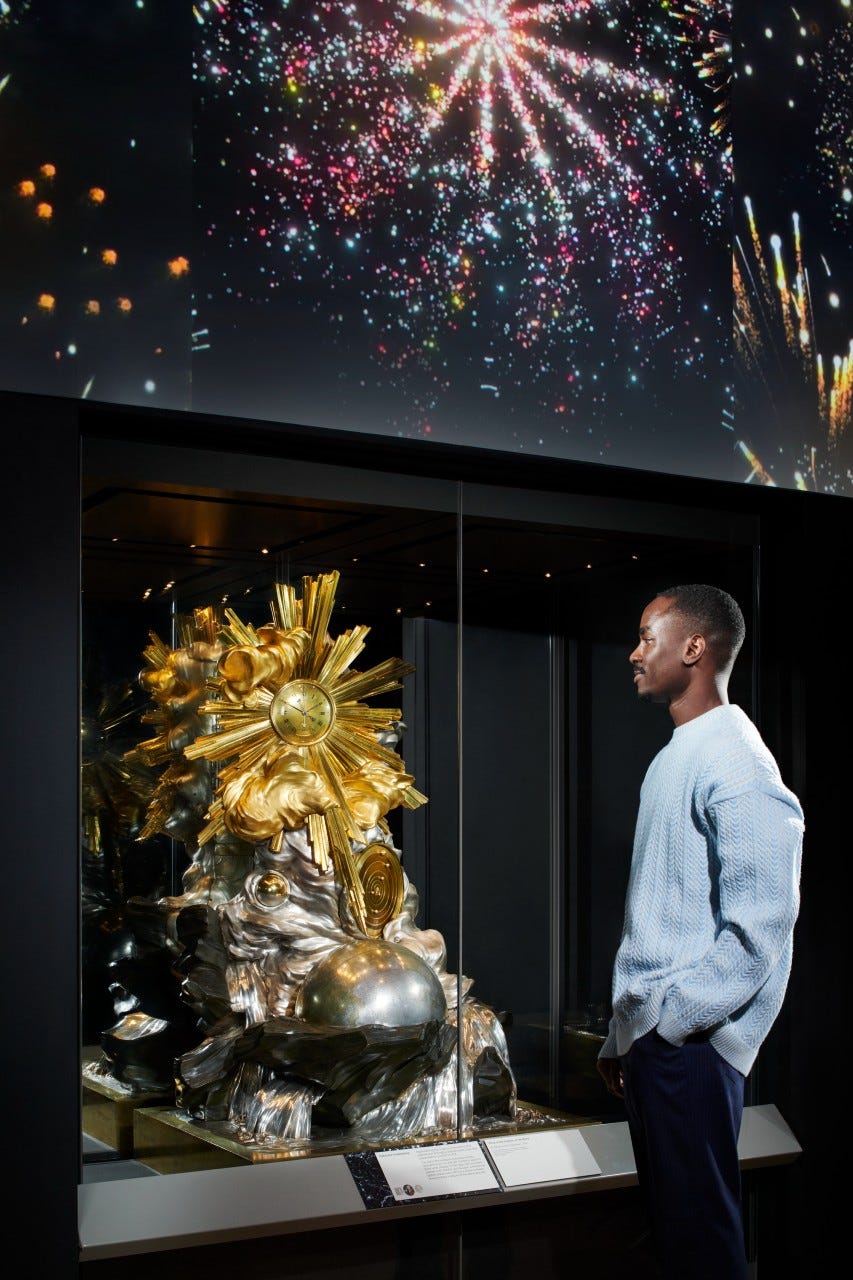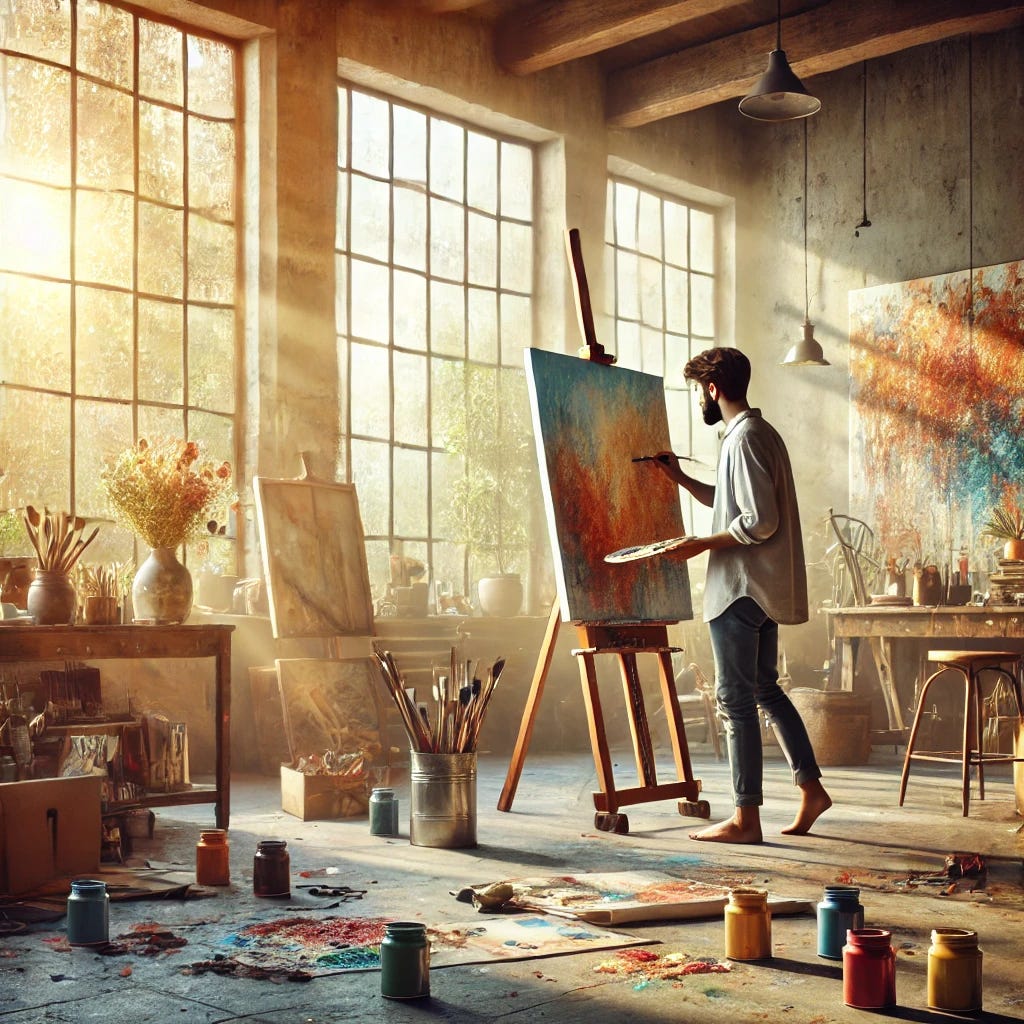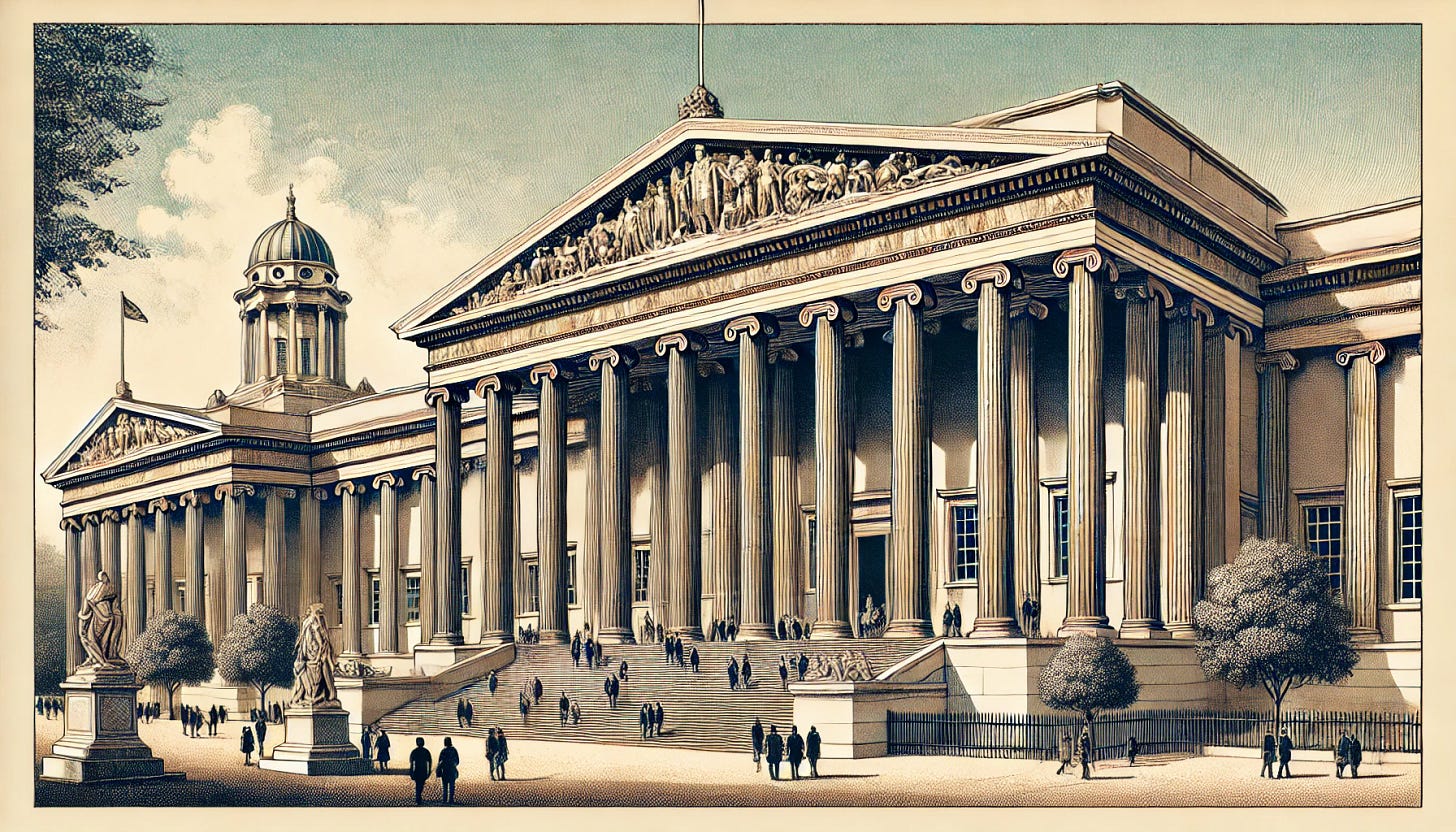— in partnership with Art UK
Hello.
It’s the final mid-week edition of the year! (But don’t worry, there’s still a couple of Friday news editions still to come).
For my final Big Interview of 2024, I dive into the biggest art world topic of the year: Artificial Intelligence. Journalist Jo Lawson-Tancred gives me (and you) the facts on art’s relationship with AI, rather than the tech-bro hype.
The Hot List gives you some final festive treats — including a last minute stocking filler.
And the 250 Take caps the year with good news: how a publicly-funded initiative to help people buy art has boosted Yorkshire Sculpture Park’s revenue, and why the scheme’s expansion into Wales is so welcome.
Let’s dive right in!
— maxwell
*Purchasing through some links in this edition helps fund this newsletter by earning me a valuable affiliate commission
— in partnership with Art UK
Boost sales with the Art UK Shop
Christmas is coming, and so the 140 institutions selling their unique products through the Art UK Shop are going to benefit.
That’s because the Shop is a destination e-commerce site for consumers looking for cultural gifts — and sales generate cash for partner museums and galleries.
“Our marketing activity helps bring these wonderful products to customers and allows shoppers the chance to give back to the collections they love” Camilla Stewart, Director of Partnerships and Collection Support at Art UK says.
That revenue is not just at Christmas though. The top-sellers earn thousands of pounds of net income per year from the Shop. Art UK’s marketing support is year-round.
It’s why the Courtauld Gallery, National Portrait Gallery and the Pier Arts Centre are just some of the collections already on the store.
Want a festive boost for your organisation too? Now’s the time to get involved, so that everything is in place in time for Christmas 2025. But you’ll be making money long before then.
Email shop@artuk.org right now to start benefiting from the Art UK Shop.

The Hot List
For the final Hot List of 2024, here are the museum and cultural treats to enjoy over the festive period.
HERITAGE
1️⃣ Christmas at Windsor Castle | at Windsor, Berkshire
The magnificent State Apartments have been decked out for Christmas including a stunning 20-foot-high tree, and miniature decorations have been added to Queen Mary’s 100-year-old Dolls’ House.
until 6 January 2025 | find out more
INSTALLATION
2️⃣ All Lit Up! — Christmas Tree 2024 | at the V&A, London
Anna Lomax’s brilliantly bold and playful tree artwork takes the columns in the V&A’s Dome as its inspiration, and manipulates them into a striking light installation that looks great on the ‘gram.
until 5 January, free | more here
EXHIBITION
3️⃣ Versailles: Science and Splendour | at the Science Museum, London
It’s not Christmassy — but it’s full of sparkle. The spectacular objects on display include the world’s most famous watch made for Marie Antoinette and Louis XV’s rhinoceros, all telling the science stories from the French palace.
until 21 April 2025 | book now

RADIO
4️⃣ What a shocker! The sensational life of Leigh Bowery | on BBC Radio 4
One of 2025’s most anticipated exhibitions at Tate Modern is the Leigh Bowery retrospective. Whet your appetite with this doc, where Nick Grimshaw looks back at the provocative life and work of the performance artist.
Tuesday 31 December, 16:00 | find out more
BOOK
5️⃣ Van Gogh: Sunflowers | by Martin Gayford
Whether you need a last minute stocking-filler or some new reading to escape the family this Christmas, this compact but rich new book deep-dives into the National Gallery’s Sunflowers painting.
published by National Gallery Global | buy now for Christmas
The Big Interview
Did you embrace AI this year? Perhaps you were inspired by the 250 Take I published in the summer on 3 ways museum professionals can start using the technology?
Or maybe, you’ve heard a lot about Artificial Intelligence, but don’t feel it’s really made inroads into your day-to-day life quite yet? I might place myself in this category.
Because for all its ubiquity in the ‘discourse,’ aside from the (annoying) new AI summaries on Google search results, I don’t feel like I notice it all that much. And I’ve only sporadically used it. (But I know talking to people who teach students or who hire for job roles, it very much is making itself known!)
I think part of the issue is that there’s a lot of noise around AI. It’s hard to distinguish between the reality, and the hype. This is especially true in the art world. Is AI going to be a genuine game-changer, or is it overblown by well-paid PR professionals?
This is where journalist Jo Lawson-Tancred comes in. Her new book — AI and the Art Market — aims to demystify AI’s relationship to art, and to offer a measured view of the current landscape. It’s the first book to offer an approachable introduction to AI for art-market professionals, and it hopes to better equip them with info on how to work with AI in an art-world context. Because again, despite the fanfare, we are all relative novices.
So for my final Big Interview of 2024, I’ve spoken to Jo — who is also a reporter for Artnet News — to get the cold, hard facts on the cold, hard realities of AI in art.
(And note, I’ve used AI to create images for this piece — the first time I’ve tried image creation. Ten points for anyone that guesses what the prompts were!)
***
Hi Jo. Let's get straight into it. AI: friend or foe?
Friend… cautiously! While my book ultimately makes a case for AI, it does not shy from delving into the technology’s weaknesses since rampant techno-optimism isn’t remotely useful in my opinion.
I feel fortunate that, as a journalist, I can take the relatively neutral stance of a spectator, observing developments and the debates they inspire. I’m interested in the wider landscape and of course any headline-grabbing controversies are exciting to cover and get clicks.
How much is AI currently used in the art world?
Everyday, general-purpose tools like ChatGPT have had a very wide pick-up, as in many other industries. My interest is predominantly in more art-specific tools like AI for authentication or for valuation and in these cases its use is only emerging in small pockets at the very fringes of the mainstream art world.
This is not surprising since the traditional art world has always been quite slow adapting to technological innovations, which must win our trust before they can become widespread. However, just last month Germann Auctions in Zurich became the first auction house to use AI authentication, provided by the start-up Art Recognition, to back three of its lots. They all managed to find a buyer.
So why does it remain only on the “fringes”? What keeps the art world hesitant?
Well, in the case of AI for authentication, the technology has had some pretty bad press! The best example is probably the “battle of the AIs” last year, when two different AI models came to opposing conclusions about whether the same painting could possibly be by Raphael. This stand-off exposed the fact that AI can easily come up with outputs that are complete nonsense if they aren’t trained from a suitably diverse, high quality and well-labelled dataset that is put together with the guidance of an expert in that artist’s oeuvre. We can’t just hand this work over to AI developers who don’t understand the data.
But, as you say, one area where you think AI can have a real positive application is in authentication of artworks. Tell us more about that.
Human expertise is still paramount when it comes to providing the broader art historical context that helps determine an artwork’s authorship. However, AI has talents we don’t, including ‘pattern recognition,’ the ability to spot even very subtle patterns shared by a group of paintings, perhaps indicating that they are by the same hand. They can do this because the size of their memories is so big — it’s as though they are seeing millions of images at the same time. By harnessing this power to complement our own strengths, we could surely build a more robust approach to authentication.
And is resistance futile — is it going to become a major part of the market come what may?
My instinct is yes, AI will inevitably become a bigger part of our practices. There will probably be tools we take for granted in a decade or two that we don’t see coming now, so it will be exciting to see what’s next.
That said, many apparently new AI developments are just the natural next stage of previous technological changes, like how AI valuation of art is emerging from online price databases, which have been around since the 1980s. It’s impossible to predict the future so I’ve tried to centre my book more on the outcomes AI developers say they hope to see.
Will artworks made by AI ever become sought after by collectors?
I think so..! After all, many artists like to experiment with new mediums so we will probably see established artists with existing collector bases start using AI.
As for more straightforward “AI artists,” I would love to see them receive more market support. The recent sale of a painting by the AI robot Ai-Da at Sotheby’s for over $1 million was a step backwards in my opinion. The work is not a legitimate artistic endeavour but a gimmicky science project that reinforces negative stereotypes about AI art, like that it lacks real creative intention. It stole attention from more persuasive projects spearheaded by actual artists, like Sougwen Chung’s paintings made in collaboration with robot D.O.UG.
And where do museums fit into all this?
Museums are crucial sources of support for artists whose work with AI is too challenging to entice much market interest. It’s great to see a museum like the V&A — with the launch of its Photography Centre last year — showcase and eventually acquire a work like Jakes Elwes’ engaging The Zizi Show, a deepfake drag cabaret exploring ethical problems with the biased training of AI. The artist told me they rely on institutional support for most of their income. Museums are also leading the way in providing a historical context for digital art with shows like Electric Dreams, now on at Tate Modern, and in the complex task of conserving fragile new media artworks for future generations.
As we approach the new year, what are your predictions for AI and the art world in 2025. What developments do you think we'll see?
I hope to see more normalisation of AI as a medium for artists of all kinds to integrate into their practices, should they wish, rather than “AI art” being treated as a separate category principally composed of low quality AI-generated pastiche. This encourages us to see AI as a threat to artists, rather than something they should be encouraged to explore for the benefit of society.
As for business practices, in a case like that of AI authentication, where there’s a concerted effort by a dedicated few to legitimise this technology in the eyes of mainstream art-market players, I think we should see slow progress in adoption, with maybe a few more mid-tier auction houses or galleries piloting the available tools.
You're also European News Reporter for Artnet News. What news story shocked you the most in the past year?
Good question… One story that comes to mind is when a vandal smashed a large porcelain work by Ai Weiwei at the opening of his show at Palazzo Fava in Bologna in September. Sadly, the artist told me the work had taken over a year to make using traditional methods as well as a lot of experimentation to achieve its unique structure. He decided not to replace it. The incident really exposed the risks involved in making artworks like these public.
And what's the story you're keeping the keenest eye on in 2025?
I’m keen to see what direction will be taken by Koyo Kouoh, the Venice Biennale’s newly appointed curator for its 61st edition in 2026. After Giorgia Meloni’s government installed right-wing journalist Pietrangelo Buttafuoco as president of the Biennale, I worried this may influence the event’s politics. The appointment of Kouoh, the first African woman in the role, is a positive indication to the contrary, but it will be interesting to learn more about her chosen themes for the main exhibition, which will be announced next year.
AI and the Art Market by Jo Lawson-Tancred and published by Lund Humphries, is available now. Buy your copy here from Bookshop.org and financially support both independent bookshops and this newsletter.
The 250 Take
2024’s final guest writer is Yorkshire Sculpture Park's Amanda Peach. Here she explains in 250 words why the Own Art initiative — that helps people spread the cost of buying art — has been so valuable to the Park’s finances.
💬 Making it easier to buy art has made our finances stronger. Now it’s Wales’ turn
“For Yorkshire Sculpture Park, our shops are much more than places to pick up a souvenir. They’re a vital part of our identity, generating essential income and highlighting contemporary artists and makers by showcasing the incredible talent we have in the UK.
As the leading international centre for modern and contemporary sculpture, YSP welcomes 380,000 visitors each year. As a charitable trust and registered museum, we rely on income generation to maintain our 500 acres of historic parkland and galleries. Our shops play a key role in this, offering something truly different to the high street, with artist and designer-led gifts, and a focus on contemporary craft.
Through a changing showcase of ceramics, jewellery, and mixed media, we’re proud to promote exceptional makers alongside internationally renowned artists and sculptors, celebrating the wealth of creativity this country offers.
Offering the Own Art scheme has been incredibly valuable, allowing customers who thought owning art was out of reach to make it possible. Spreading the cost over 10 months makes it more affordable, opening up a way for people to bring art into their lives. In the past five years, YSP has sold over 400 pieces of art and craft through Own Art, contributing over £75,000 in revenue, and promoting the work of over 50 artists, designers and makers.
With Own Art celebrating its 20th anniversary and expanding into Wales, it is opening doors for galleries and artists across the UK by raising awareness of the breadth of talented crafts makers in this country.”
— Amanda Peach is Yorkshire Sculpture Park's Retail Programme and Development Manager. The Own Art scheme is available for purchases of select artwork from the Yorkshire Sculpture Park shop, and in over 300 organisations across the UK, including Wales for the first time.
Enjoyed this newsletter? It took many hours to put together. Donate now to support me as I continue to bring you insights from the world of museums, galleries, art and heritage.







